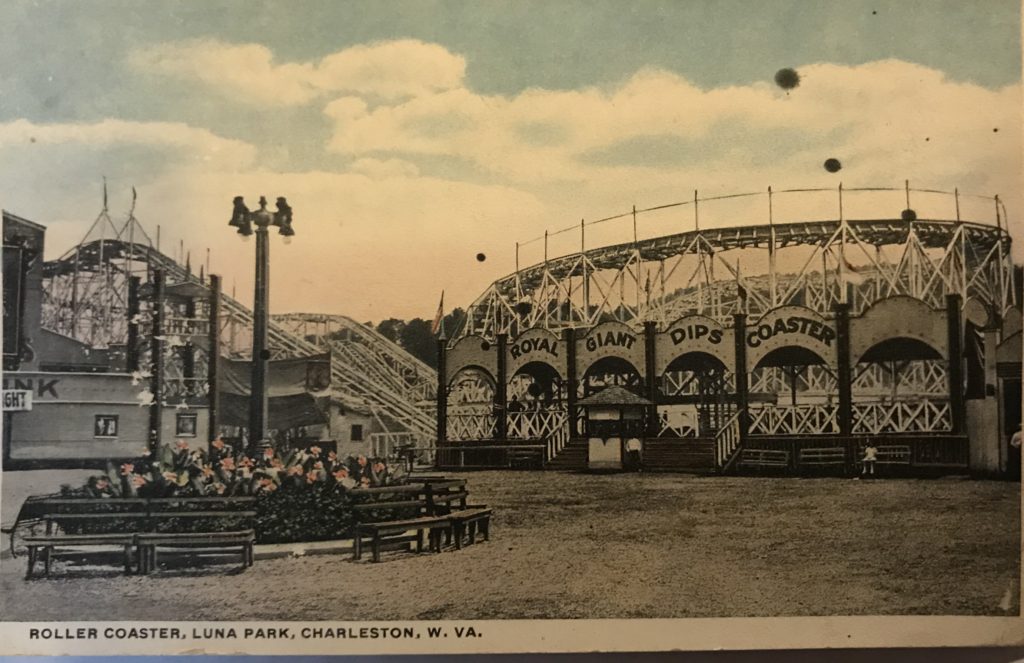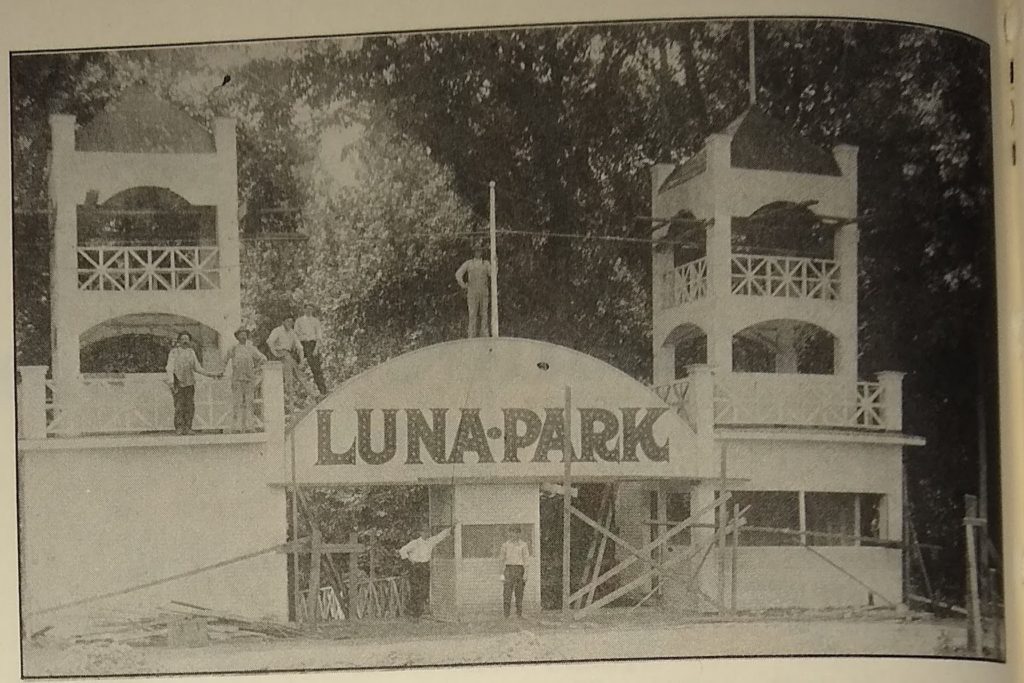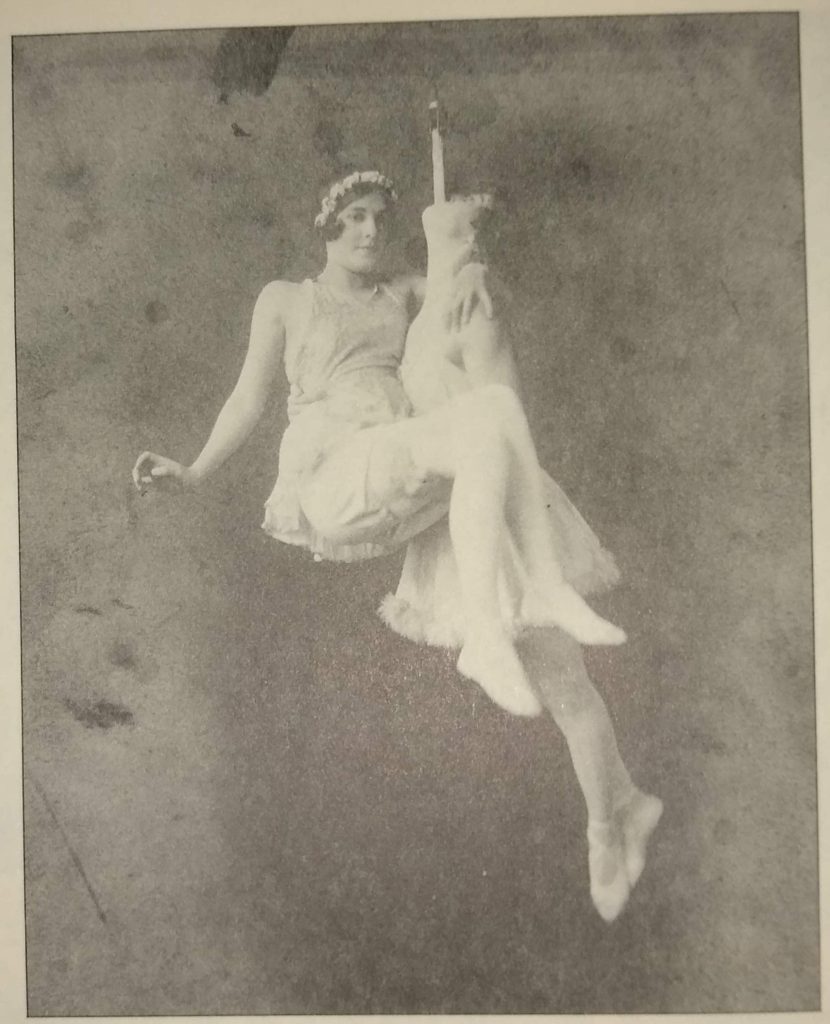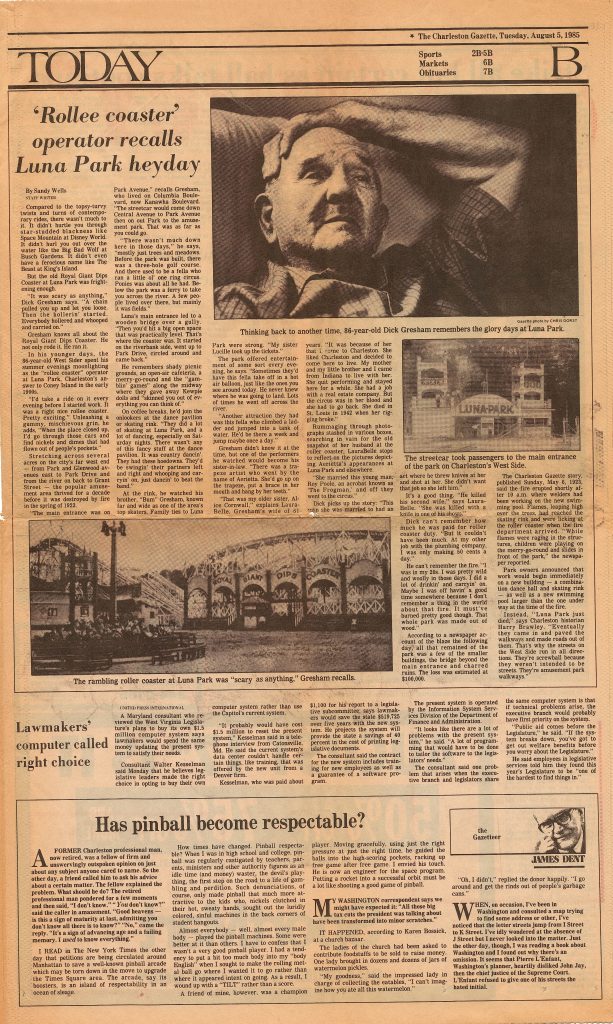“Rollee Coaster” operator recalls Luna Park heyday
by Sandy Wells | The Charleston Gazette

Compared to the topsy-turvy twists and turns of contemporary rides, there wasn’t much to it. It didn’t hurtle you through star-studded blackness like Space Mountain at Disney World. It didn’t hurl you out over the water like the Big Bad Wolf at Busch Gardens. It didn’t even have a ferocious name like The Beast at King’s Island.
But the old Royal Giant Dips Coaster at Luna Park was frightening enough.
“It was scary as anything,” Dick Gresham says. “A chain pulled you up and let you loose. Then the hollerin’ started. Everybody hollered and whooped and carried on.”
Gresham knows all about the Royal Giant Dips Coaster. He not only rode it. He ran it.
In his younger days, the 86-year-old West Sider spent his summer evenings moonlighting as the “rollee coaster” operator at Luna Park, Charleston’s answer to Coney Island in the early 1900s.
“I’d take a ride on it every evening before I started work. It was a right nice rollee coaster. Pretty exciting.” Unleashing a gummy, mischievous grin, he adds, “When the place closed up, I’d go through those cars and find nickels and dimes that had flown out of people’s pockets.”

Stretching across several acres on the city’s far west end — from Park and Glenwood avenues east to Park Drive and from the river on back to Grant Street — the popular amusement area thrived for a decade before it was destroyed by fire in the spring of 1923.
“The main entrance was on Park Avenue,” recalls Gresham, who lived on Columbia Boulevard, now Kanawha Boulevard. “The streetcar would come down Central Avenue to Park Avenue then on out Park to the amusement park. That was as far as you could go.
“There wasn’t much down here in those days,” he says, “mostly just trees and meadows. Before the park was built, there was a three-hole golf course. And there used to be a fella who ran a little ol’ one ring circus. Ponies was about all he had. Below the park was a ferry to take you across the river. A few people lived over there, but mainly it was fields.”
Luna’s main entrance led to a wooden bridge over a gully. “Then you’d hit a big open space that was practically level. That’s where the coaster was. It started on the riverbank side, went up to Park Drive, circled around and came back.”

He remembers shady picnic grounds, an open-air cafeteria, a merry-go-round and the “gamblin’ games” along the midway where they gave away Kewpie dolls and “skinned you out of everything you can think of.”
On coffee breaks, he’d join the onlookers at the dance pavilion or skating rink. “They did a lot of skating at Luna Park, and a lot of dancing, especially on Saturday nights. There wasn’t any of this fancy stuff at the dance pavilion. It was country dancin’. They had these hoedowns. They’d be swingin’ their partners left and right and whooping and carryin’ on, just dancin’ to beat the band.”
At the rink, he watched his brother, “Bum” Gresham, known far and wide as one of the area’s top skaters. Family ties to Luna Park were strong. “My sister Lucille took up the tickets.”
The park offered entertainment of some sort every evening, he says. “Sometimes they’d have this fella take off in a hot air balloon, just like the ones you see around today. He never knew where he was going to land. Lots of times he went off across the river.
“Another attraction they had was this fella who climbed a ladder and jumped into a tank of water. He’d be there a week and jump maybe once a day.”
Gresham didn’t know it at the time, but one of the performers he watched would become his sister-in-law. “There was a trapeze artist who went by the name of Aerietta. She’d go up on the trapeze, put a brace in her mouth and hang by her teeth.”
“That was my older sister, Alice Cornwall,” explains LauraBelle, Gresham’s wife of 61 years. “It was because of her that I came to Charleston. She liked Charleston and decided to come here to live. My mother and my little brother and I came from Indiana to live with her. She quit performing and stayed here for a while. She had a job with a real estate company. But the circus was in her blood and she had to go back. She died in St. Louis in 1942 when her rigging broke.”
Rummaging through photographs stashed in various boxes, searching in vain for the old snapshot of her husband at the roller coaster, LauraBelle stops to reflect on the pictures depicting Aerietta’s appearances at Luna Park and elsewhere.

“She married this young man, Roy Poole, an acrobat known as ‘The Frogman,’ and off they went to the circus.”
Dick picks up the story: “This man she was married to had an act where he threw knives at her and shot at her. She didn’t want that job so she left him.”
It’s a good thing. “He killed his second wife,” says LauraBelle. “She was killed with a knife in one of his shows.”
Dick can’t remember how much he was paid for roller coaster duty. “But it couldn’t have been much. At my other job with the plumbing company I was only making 50 cents a day.”
He can’t remember the fire. “I was in my 20s. I was pretty wild and woolly in those days. I did a lot of drinkin’ and carryin’ on. Maybe I was off havin’ a good time somewhere because I don’t remember a thing in the world about that fire. It must’ve burned pretty good though. That whole park was made out of wood.”
According to a newspaper account of the blaze the following day, all that remained of the park was a few of the smaller buildings, the bridge beyond the main entrance and charred ruins. The loss was estimated at $100,000.
The Charleston Gazette story, published Sunday, May 6, 1923, said the fire erupted shortly after 10 a.m. where welders had been working on the new swimming pool. Flames, leaping high over the trees, had reached the skating rink and were licking at the roller coaster when the fire department arrived. “While flames were raging in the structures, children were playing on the merry-go-round and slides in front of the park,” the newspaper reported.
Park owners announced that work would begin immediately on a new building — a combination dance hall and skating rink — as well as a new swimming pool larger than the one under way at the time of the fire.
Instead, “Luna Park just died,” says Charleston historian Harry Brawley. “Eventually they came in and paved the walkways and made roads out of them. That’s why the streets on the West Side run in all directions. They’re screwball because they weren’t intended to be streets. They’re amusement park walkways.”

